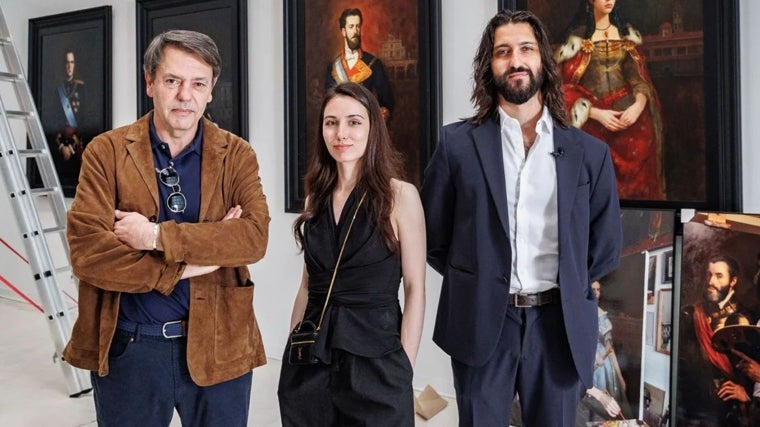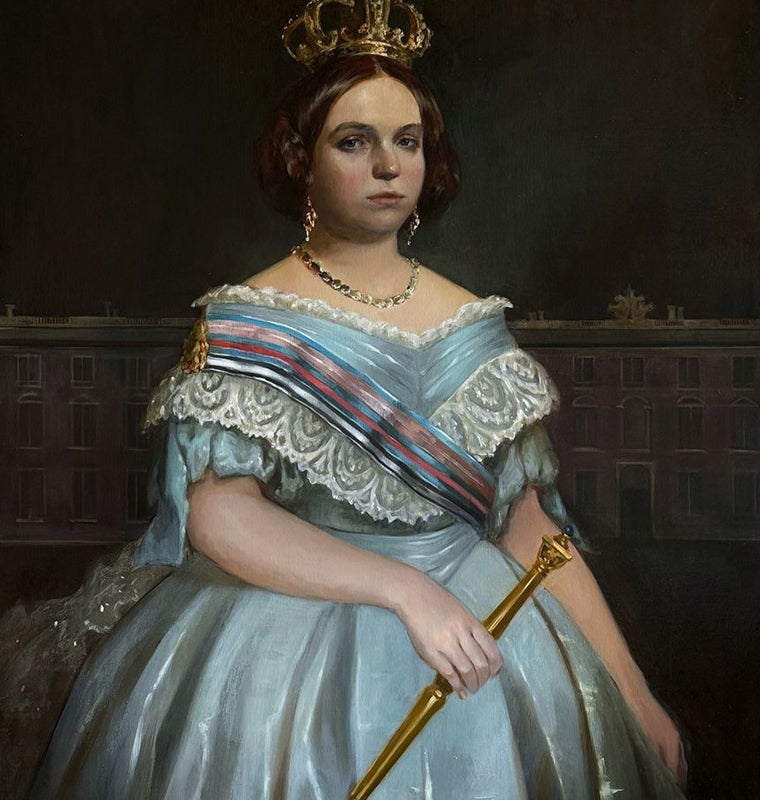All the queens that Spain has had and that Ferrer-Dalmau will paint

Mothers, daughters, and sisters; all of them precocious and feisty women, yet, above all, the backbone of our national past. Augusto Ferrer-Dalmau 's studio will bring to life the queens who have passed through Spanish history since the 15th century. And even a little earlier. "There will be 30 in total. We have included Lady Urraca I of León , the first full-fledged queen in Europe, and Himilce , wife of Hannibal, as a precursor to all of them." The voice of the battle painter—now also a court painter—hides the spark of someone tackling a new project; one unprecedented to date. "It's never been done before, we're going to be the first. And that's also a great responsibility," adds the artist.
The series' zenith will be Queen Letizia , the most popular face of a saga of monarchs (feminine) who, Ferrer-Dalmau asserts, have remained more in the shadow of history than they should have. "With the Collection of the Queens of Spain, we seek to vindicate their importance in the country's past and highlight the role they played throughout the centuries; to shed light on them, in short. They are the great unknowns, and that is very unfair," the battle painter explains to this newspaper. The project, promoted by the Ferrer-Dalmau Foundation , will be carried out by the young artists in his workshop under his constant tutelage and the coordination of Alejo Segarra, the most gifted of his pupils.
According to Ferrer-Dalmau himself, the historical documentation and subsequent painting of the canvases will take a year and a half. During that time, ABC will exclusively publish the paintings, accompanied by a biography of each of the monarchs . "The workshop will begin work in the summer. The idea is to first finish the Collection of the Kings of Spain , the gallery of monarchs we presented a month ago in Madrid and which will be exhibited at the Palace of Infante Don Luis de Boadilla del Monte," he adds. Although they have already painted several queens for this project, the artist asserts that they will create new paintings for this collection.
The collection will begin, chronologically, with Himilce , the wife of the Carthaginian general Hannibal . "We've included her as a direct predecessor of the queens of Spain," Noemí Toral tells ABC. The researcher, educator, and designer is convinced there's no better character to kick things off; and she knows what she's talking about, as she was responsible for designing the final list of monarchs who will be transferred to the canvas.
She will be followed by Queen Urraca I of León . "She is the first full-fledged queen of Europe. This milestone is a source of pride for us," says the advisor to Ferrer-Dalmau. The monarch, born in the 11th century, ascended to the throne after her father, Alfonso VI, died without a male heir. Since then, and as Isabel San Sebastián revealed in the popular novel ' La temeraria ', she fought against everything and everyone to safeguard her rights.
 Juan la Loca, for the Collection of Kings of Spain
AUGUSTO FERRER-DALMAU WORKSHOP
Juan la Loca, for the Collection of Kings of Spain
AUGUSTO FERRER-DALMAU WORKSHOP
It wasn't until four centuries later that the peninsula gave birth to the one who would become a key figure in the consolidation of the Spanish monarchy: Isabella I of Castile. Naturally, the Catholic Queen will also have her painting in this gallery, promoted by the Ferrer-Dalmau Foundation. " She was the best monarch Europe has ever had; overshadowing any who came later. One example is that she laid the foundations for future human rights after arriving in the New World," adds Toral. After her came other equally popular queens, such as Juana I of Castile , better known as "the Mad," or the equally famous Isabella II , the figurehead in the forging of the liberal state and the abandonment of the Ancien Régime during the 19th century.
 From left to right: Ferrer-Dalmau, Alissa S. and Alejo Segarra
Tania Sieira
From left to right: Ferrer-Dalmau, Alissa S. and Alejo Segarra
Tania Sieira
However, Ferrer-Dalmau asserts, another objective of this project is to bring women who have tiptoed through Spanish history out of the shadows. Because there were some, indeed. "Two examples are the wife of Joseph I Bonaparte and the wife of Amadeo of Savoy . Today, we are not taught who they were or what their lives were like. We want to change that," adds Toral. The first, Julie Clary , never set foot on the Peninsula despite being the queen consort. The second, the ephemeral María Victoria dal Pozzo , was one of the most charitable and cultured maidens of the court. "We want to give them a place in the present day and ensure that society takes an interest in their lives," concludes the battle painter.
The mountain to climb is steep, as both the teacher and the advisor know well; and not just for the obvious reasons, but because each portrait requires many hours of research in archives and arduous documentation work. "Nothing is painted haphazardly. One of the fundamental aspects of this project will be to discover the aesthetics of each era: to understand how the queens dressed in order to perfectly represent them in the portrait," Toral adds. She isn't afraid of the challenge, having dedicated her entire professional life to it. "Augusto knows that I take care of every last detail so that everything is perfect," she concludes.
However, the historical advisor adds, the paintings will also include "small nods to the personalities" of their subjects. Little details that, for now, she hasn't revealed to us. We have to maintain some mystery!
 Isabel II, for the Collection of Kings of Spain
AUGUSTO FERRER-DALMAU WORKSHOP
Isabel II, for the Collection of Kings of Spain
AUGUSTO FERRER-DALMAU WORKSHOP
Toral also admits that the Queens of Spain Collection faces several challenges: "One of them is depicting Joanna of Castile , Isabella's daughter and successor. She was a person who, due to her mental illness, refused to have her portrait painted during her lifetime. In practice, we have little to draw on to evoke her features. The same thing happens with clothing: when she was in Flanders, she liked to dress like a Spanish woman, and vice versa." The second is Isabella of Portugal , the wife of Charles V. "Most of the paintings we have of her are posthumous. Her image has been idealized. We are going to try to bring her closer to reality," he adds.
Thus, in a combination of brushes and historical archives, the memory of the women who built Spain will resurface. "This collection is an act of historical justice," explains Ferrer-Dalmau. And we embrace her words.
1-Himilce (wife of General Hannibal). Precursor of the Spanish monarchs.
2-Doña Urraca I of León.
3-Isabel I of Castile.
4-Joanna I of Castile.
5-Elizabeth of Portugal (wife of Charles V).
6-Isabel de Valois (wife of Philip II).
7-Mary Tudor (wife of Philip II).
8-Anna of Austria (wife of Philip II).
9-Margarita of Austria (wife of Philip III).
10-Isabel de Borbón (wife of Philip IV).
11-Mariana of Austria (wife of Philip IV).
12-Marie Louise of Orleans (wife of Charles II).
13-Mariana of Neuburg (wife of Charles II).
14-Maria Luisa Gabriela of Savoy (wife of Philip V).
15-Isabel Farnese (wife of Philip V).
16-Louise Elizabeth of Orleans (wife of Louis I).
17-Barbara of Braganza (wife of Ferdinand VI).
18-Maria Amalia of Saxony (wife of Charles III).
19-María Luisa de Borbón (wife of Carlos IV).
20-Julia Clary (wife of Joseph I).
21-María Isabel of Portugal (wife of Ferdinand VII).
22-Maria Josefa Amalia of Saxony (wife of Ferdinand VII).
23-Maria Cristina Bourbon-Two Sicilies.
24-Elizabeth II.
25-Maria Victoria dal Pozzo (wife of Amadeo of Savoy).
26-María de las Mercedes de Orleans (wife of Alfonso XII).
27-Maria Christina of Austria (wife of Alfonso XII).
28-Victoria Eugenia de Battenberg (wife of Alfonso XIII).
29-Sofia of Greece (wife of Juan Carlos I).
30-Letizia Ortiz Rocasolano (wife of Felipe VI).
ABC.es





